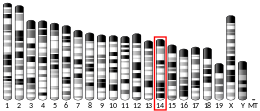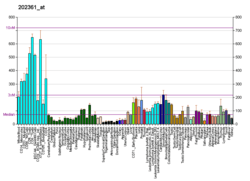SEC24C
Protein transport protein Sec24C is a protein that in humans is encoded by the SEC24C gene.[5][6][7]
Function
The protein encoded by this gene is a member of the SEC24 subfamily of the SEC23/SEC24 family, which is involved in vesicle trafficking. The encoded protein has similarity to yeast Sec24p component of COPII. COPII is the coat protein complex responsible for vesicle budding from the ER. The product of this gene may play a role in shaping the vesicle, as well as in cargo selection and concentration. Alternatively spliced transcript variants encoding the same protein have been identified.[7]
Interactions
SEC24C has been shown to interact with SEC23A.[8]
gollark: \<@&348696018113658884>
gollark: I just did.
gollark: \<@&348696018113658884>
gollark: ```Don't you know how much you can save per machine by not including a hardware button? Cents, cents I tell you!```
gollark: \@everyone
References
- GRCh38: Ensembl release 89: ENSG00000176986 - Ensembl, May 2017
- GRCm38: Ensembl release 89: ENSMUSG00000039367 - Ensembl, May 2017
- "Human PubMed Reference:". National Center for Biotechnology Information, U.S. National Library of Medicine.
- "Mouse PubMed Reference:". National Center for Biotechnology Information, U.S. National Library of Medicine.
- Tani K, Oyama Y, Hatsuzawa K, Tagaya M (May 1999). "Hypothetical protein KIAA0079 is a mammalian homologue of yeast Sec24p". FEBS Lett. 447 (2–3): 247–50. doi:10.1016/S0014-5793(99)00303-8. PMID 10214955.
- Nomura N, Nagase T, Miyajima N, Sazuka T, Tanaka A, Sato S, Seki N, Kawarabayasi Y, Ishikawa K, Tabata S (1994). "Prediction of the coding sequences of unidentified human genes. II. The coding sequences of 40 new genes (KIAA0041-KIAA0080) deduced by analysis of cDNA clones from human cell line KG-1". DNA Res. 1 (5): 223–9. doi:10.1093/dnares/1.5.223. PMID 7584044.
- "Entrez Gene: SEC24C SEC24 related gene family, member C (S. cerevisiae)".
- Pagano A, Letourneur F, Garcia-Estefania D, Carpentier JL, Orci L, Paccaud JP (Mar 1999). "Sec24 proteins and sorting at the endoplasmic reticulum". J. Biol. Chem. 274 (12): 7833–40. doi:10.1074/jbc.274.12.7833. PMID 10075675.
Further reading
- Tang BL, Kausalya J, Low DY, Lock ML, Hong W (1999). "A family of mammalian proteins homologous to yeast Sec24p". Biochem. Biophys. Res. Commun. 258 (3): 679–84. doi:10.1006/bbrc.1999.0574. PMID 10329445.
- Dudognon P, Maeder-Garavaglia C, Carpentier JL, Paccaud JP (2004). "Regulation of a COPII component by cytosolic O-glycosylation during mitosis". FEBS Lett. 561 (1–3): 44–50. doi:10.1016/S0014-5793(04)00109-7. PMID 15013749.
- Beausoleil SA, Jedrychowski M, Schwartz D, Elias JE, Villén J, Li J, Cohn MA, Cantley LC, Gygi SP (2004). "Large-scale characterization of HeLa cell nuclear phosphoproteins". Proc. Natl. Acad. Sci. U.S.A. 101 (33): 12130–5. doi:10.1073/pnas.0404720101. PMC 514446. PMID 15302935.
- Rual JF, Venkatesan K, Hao T, Hirozane-Kishikawa T, Dricot A, Li N, Berriz GF, Gibbons FD, Dreze M, Ayivi-Guedehoussou N, Klitgord N, Simon C, Boxem M, Milstein S, Rosenberg J, Goldberg DS, Zhang LV, Wong SL, Franklin G, Li S, Albala JS, Lim J, Fraughton C, Llamosas E, Cevik S, Bex C, Lamesch P, Sikorski RS, Vandenhaute J, Zoghbi HY, Smolyar A, Bosak S, Sequerra R, Doucette-Stamm L, Cusick ME, Hill DE, Roth FP, Vidal M (2005). "Towards a proteome-scale map of the human protein-protein interaction network". Nature. 437 (7062): 1173–8. doi:10.1038/nature04209. PMID 16189514.
This article is issued from Wikipedia. The text is licensed under Creative Commons - Attribution - Sharealike. Additional terms may apply for the media files.




